嵌入式系统组成结构简介共73页
- 格式:ppt
- 大小:6.71 MB
- 文档页数:73
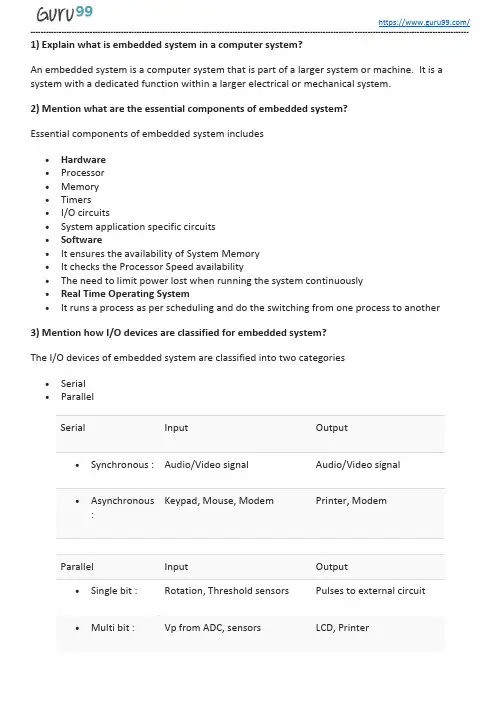
1) Explain what is embedded system in a computer system?An embedded system is a computer system that is part of a larger system or machine. It is a system with a dedicated function within a larger electrical or mechanical system.2) Mention what are the essential components of embedded system?Essential components of embedded system includes•Hardware•Processor•Memory•Timers•I/O circuits•System application specific circuits•Software•It ensures the availability of System Memory•It checks the Processor Speed availability•The need to limit power lost when running the system continuously•Real Time Operating System•It runs a process as per scheduling and do the switching from one process to another 3) Mention how I/O devices are classified for embedded system?The I/O devices of embedded system are classified into two categories•Serial•Parallel•Synchronous : Audio/Video signal Audio/Video signal•Single bit : Rotation, Threshold sensors Pulses to external circuit•Multi bit : Vp from ADC, sensors LCD, Printer4) Why embedded system is useful?With embedded system, it is possible to replace dozens or even more of hardware logic gates, input buffers, timing circuits, output drivers, etc. with a relatively cheap microprocessor.5) Explain what are real-time embedded systems?Real-time embedded systems are computer systems that monitor, respond or control an external environment. This environment is connected to the computer system through actuators, sensors, and other input-output interfaces.6) Explain what is microcontroller?The microcontroller is a self-contained system with peripherals, memory and a processor that can be used as embedded system.7) Mention what is the difference between microprocessor and microcontroller? Microprocessor is managers of the resources (I/O, memory) which lie outside of its architecture Microcontroller have I/O, memory, etc. built into it and specifically designed for control8) What does DMA address will deal with?DMA address deals with physical addresses. It is a device which directly drives the data and address bus during data transfer. So, it is purely physical address.9) Explain what is interrupt latency? How can you reduce it?Interrupt latency is a time taken to return from the interrupt service routine post handling a specific interrupt. By writing minor ISR routines, interrupt latency can be reduced.10) Mention what are buses used for communication in embedded system?For embedded system, the buses used for communication includes•I2C: It is used for communication between multiple ICs•CAN: It is used in automobiles with centrally controlled network•USB: It is used for communication between CPU and devices like mouse, etc.While ISA, EISA, PCI are standard buses for parallel communication used in PCs, computer network devices, etc.11) List out various uses of timers in embedded system?Timers in embedded system are used in multiple ways•Real Time Clock (RTC) for the system•Initiating an event after a preset time delay•Initiating an even after a comparison of preset times•Capturing the count value in timer on an event•Between two events finding the time interval•Time slicing for various tasks•Time division multiplexing•Scheduling of various tasks in RTOS12) Explain what is a Watchdog Timer?A watchdog timer is an electronic device or electronic card that execute specific operation after certain time period if something goes wrong with an electronic system.13) Explain what is the need for an infinite loop in embedded systems?Embedded systems require infinite loops for repeatedly processing or monitoring the state of the program. For instance, the case of a program state continuously being verified for any exceptional errors that might just happen during run-time such as memory outage or divide by zero, etc.14) List out some of the commonly found errors in Embedded Systems?Some of the commonly found errors in embedded systems are•Damage of memory devices static discharges and transient current•Address line malfunctioning due to a short in circuit•Data lines malfunctioning•Due to garbage or errors some memory locations being inaccessible in storage•Inappropriate insertion of memory devices into the memory slots•Wrong control signals15) Explain what is semaphore?A semaphore is an abstract datatype or variable that is used for controlling access, by multiple processes to a common resource in a concurrent system such as multiprogramming operating system. Semaphores are commonly used for two purposes•To share a common memory space•To share access to files16) Explain what is the difference between mutexes and semaphores?• A mutex object enables one thread into a controlled section, forcing other threads which tries to gain access to that section to wait until the first thread has movedout from that section •Semaphore allowsmultiple access to sharedresources•Mutex will always have a known owner •While for semaphore youwon’t know which threadwe are blocking on•Mutex is also a tool that is used to provide deadlock-free mutual exclusion (eitherconsumer or producer can have the keyand proceed with their work) •Semaphore is asynchronization tool toovercome the criticalsection problem•Mutexes by definition are binary semaphores, so there are two states locked or unlocked •Semaphores are usually referred to counted locks17) When one must use recursion function? Mention what happens when recursion functions are declared inline?Recursion function can be used when you are aware of the number of recursive calls is not excessive. Inline functions property says whenever it will called, it will copy the complete definition of that function. Recursive function declared as inline creates the burden on the compilers execution.18) Explain whether we can use semaphore or mutex or spinlock in interrupt context in Linux Kernel?Semaphore or Mutex cannot be used for interrupt context in Linux Kernel. While spinlocks can be used for locking in interrupt context.Guru99 Provides FREE ONLINE TUTORIAL on Various courses likeSelenium CCNA AngularJS NodeJS PLSQL。

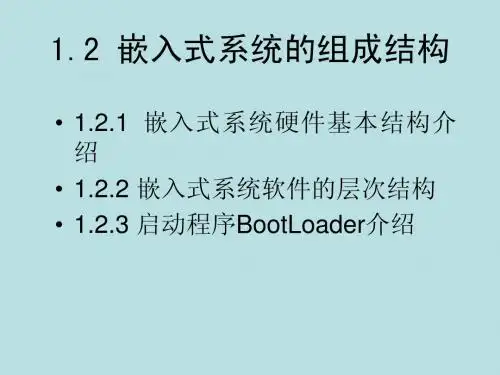
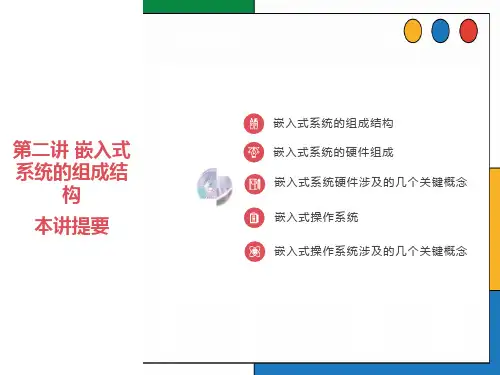

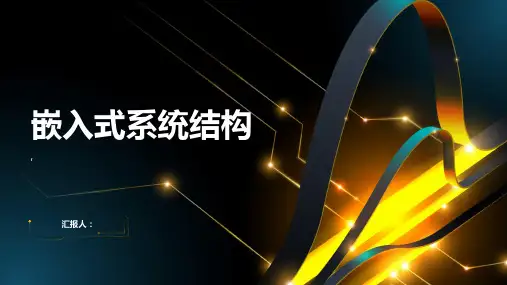
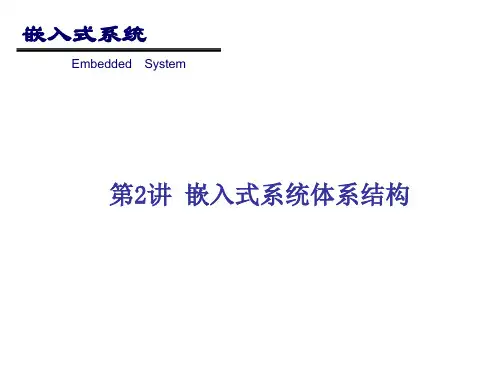
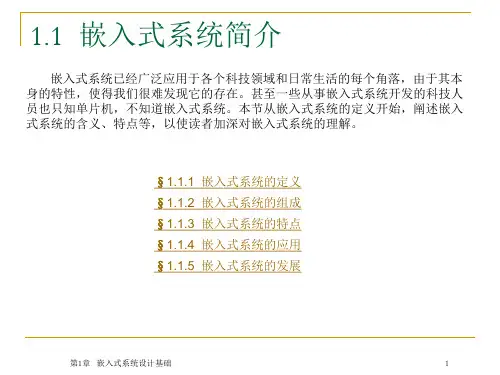

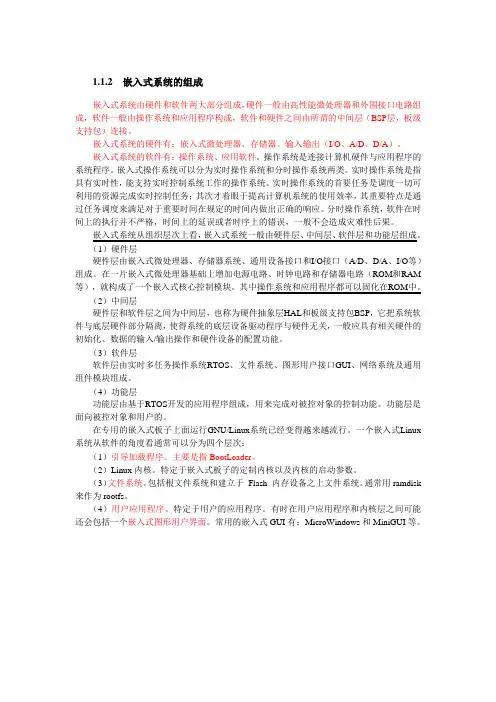
1.1.2 嵌入式系统的组成嵌入式系统由硬件和软件两大部分组成,硬件一般由高性能微处理器和外围接口电路组成,软件一般由操作系统和应用程序构成,软件和硬件之间由所谓的中间层(BSP层,板级支持包)连接。
嵌入式系统的硬件有:嵌入式微处理器、存储器、输入输出(I/O、A/D、D/A)。
嵌入式系统的软件有:操作系统、应用软件。
操作系统是连接计算机硬件与应用程序的系统程序。
嵌入式操作系统可以分为实时操作系统和分时操作系统两类。
实时操作系统是指具有实时性,能支持实时控制系统工作的操作系统。
实时操作系统的首要任务是调度一切可利用的资源完成实时控制任务;其次才着眼于提高计算机系统的使用效率,其重要特点是通过任务调度来满足对于重要时间在规定的时间内做出正确的响应。
分时操作系统,软件在时间上的执行并不严格,时间上的延误或者时序上的错误,一般不会造成灾难性后果。
嵌入式系统从组织层次上看,嵌入式系统一般由硬件层、中间层、软件层和功能层组成。
(1)硬件层硬件层由嵌入式微处理器、存储器系统、通用设备接口和I/O接口(A/D、D/A、I/O等)组成。
在一片嵌入式微处理器基础上增加电源电路、时钟电路和存储器电路(ROM和RAM 等),就构成了一个嵌入式核心控制模块。
其中操作系统和应用程序都可以固化在ROM中。
(2)中间层硬件层和软件层之间为中间层,也称为硬件抽象层HAL和板级支持包BSP,它把系统软件与底层硬件部分隔离,使得系统的底层设备驱动程序与硬件无关,一般应具有相关硬件的初始化、数据的输入/输出操作和硬件设备的配置功能。
(3)软件层软件层由实时多任务操作系统RTOS、文件系统、图形用户接口GUI、网络系统及通用组件模块组成。
(4)功能层功能层由基于RTOS开发的应用程序组成,用来完成对被控对象的控制功能。
功能层是面向被控对象和用户的。
在专用的嵌入式板子上面运行GNU/Linux系统已经变得越来越流行。
一个嵌入式Linux 系统从软件的角度看通常可以分为四个层次:(1)引导加载程序。
